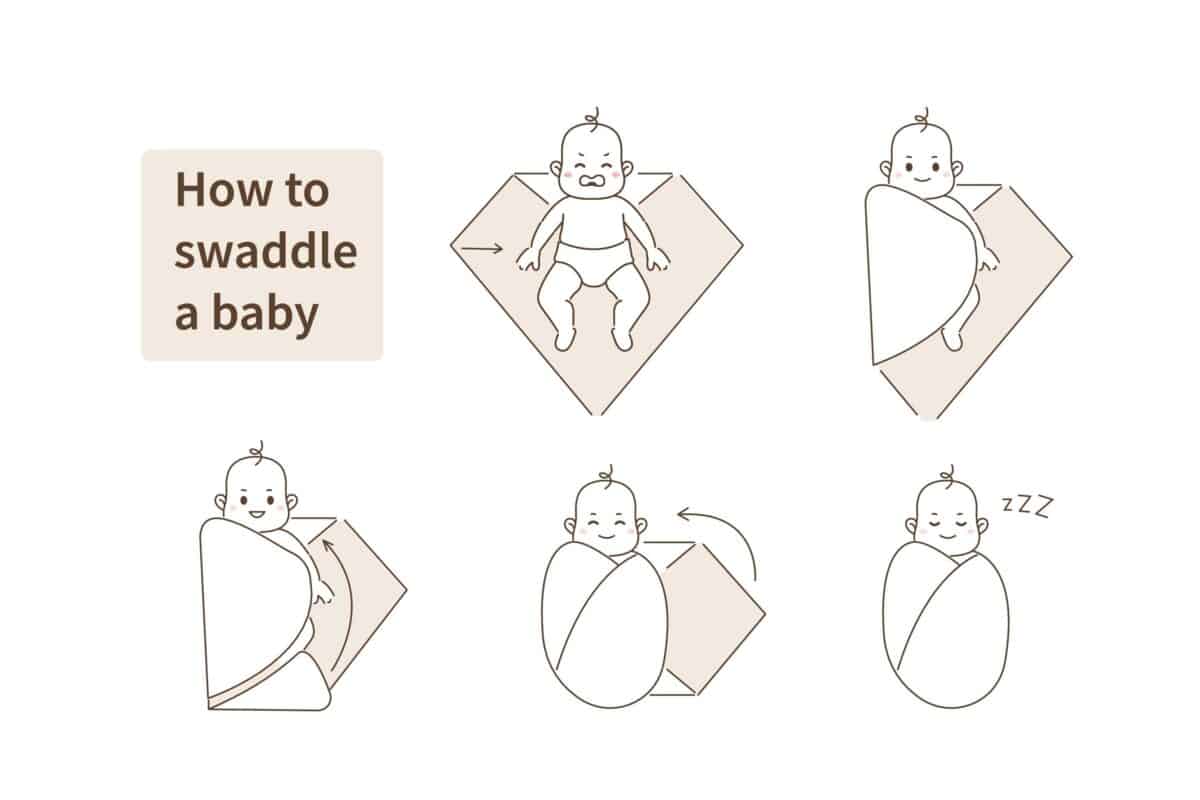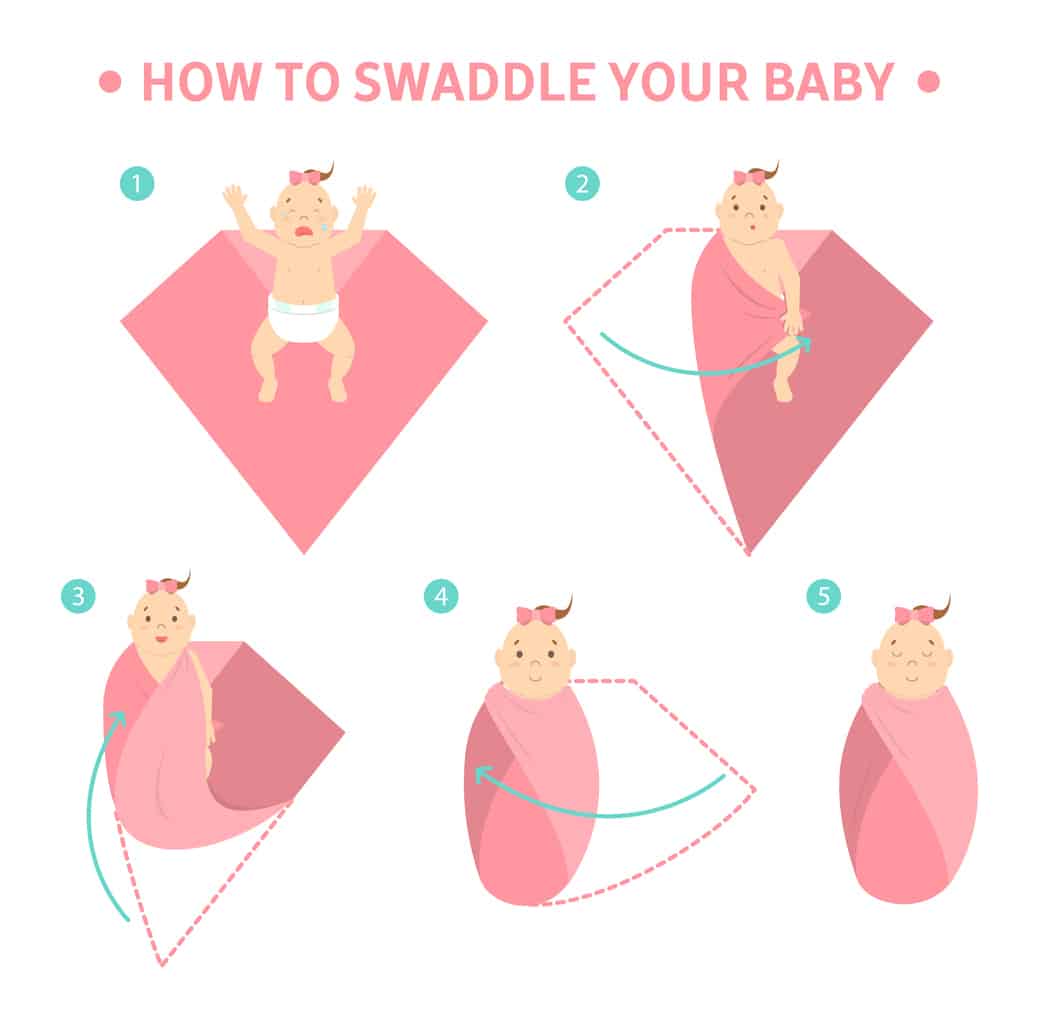One of the first lessons that many new parents need to learn is how to swaddle a baby. It is one of those things that looks easy when someone else does it, but it gets a little more complicated when you first try it out. We won’t lie. For most parents, swaddling does take some practice, but we are here to help. Today, we will talk about the importance of swaddling your baby and how to make the process as easy as possible.
Key Points
- Swaddling your baby can help reduce the risk of SIDS, since it forces them to sleep on their back.
- Swaddling can also help reduce the chances of colic, a condition where a baby cries uncontrollably with no cause.
- Swaddling will help your baby sleep longer and will keep their temperature regulated.
Why Do You Need To Learn How to Swaddle a Baby?

It is important to learn how to properly swaddle for the safety of your baby.
©Tomsickova Tatyana/Shutterstock.com
Parents have been swaddling their babies for centuries, and the technique and the materials that we use have not really changed that much over the years. While babies were likely originally swaddled because they wanted the babies to be comfortable and safe from the elements, over time, science and new developments have made it almost a necessity to swaddle our kids.
There are several reasons why it is important to learn how to swaddle a baby:
Reduce the Risk of SIDS
Over the years, we have learned a lot about the dangers of Sudden Infant Death Syndrome (SIDS). If you are unaware, SIDS is exactly as it sounds. It is an unexpected death that typically happens during sleep to babies that are under 1 year of age. While there is no scientifically proven reason that kids have SIDS, there are many possibilities. Among them are potential birth defects, low birth weight, or a sudden respiratory infection.
However, there are also factors related to sleep. For instance, if your baby turns and begins to sleep on their side, then they may have trouble breathing. Also, if a child sleeps on a soft surface, then they could be in danger of unexpectedly having a blocked airway.
Swaddling your baby can help fight the possibility of SIDS because it requires your baby to stay in one sleeping position: on their back. This is the safest position for sleeping, and it will greatly reduce the chances of SIDS.
Prevent Colic
Another common issue that can be avoided with swaddling is the chance of your child having colic. According to Hopkins Medicine, colic is when your baby cries continuously for a long time for no real rhyme or reason. Colic is most common during the child’s first 6 weeks of life, but it can go until age 3 or 4 months. Although not life-threatening, this nonstop crying can be stressful for the baby and mom and dad.
While there is no proven reason, many parents have found that swaddling their kids can help to reduce the chances of colic. One potential reason is that swaddling applies very light pressure to the baby’s tummy, which helps to relieve any pain or discomfort. Also, it gives them the feeling of being back in mommy’s tummy, and that can provide them with incredible security, and they may stop crying.
Help Your Baby to Sleep Longer
When your child is young, sleep is essential. Sleep is good for their health, and it makes it easier for parents to get used to caring for a child. Kids often sleep better when swaddled because they enjoy that feeling of being in the womb.
Also, when you swaddle your baby properly with their hands crossed over their heart, it helps them to soothe themselves. So, even if they do wake up on their own, they are more likely able to fall back to sleep on their own.
Regulate Your Baby’s Temperature
Your child is not able to regulate their temperature until they turn 2 years old. It is important that they can stay warm enough as they sleep so they don’t catch a cold or worse. As a baby, they depend on you to ensure that they are safe. By swaddling your child, you can keep them warm enough at night so they don’t get sick. Plus, if your baby gets cold, then they could wake up often.
Help Your Baby If They Cry
If your baby is crying a lot, then swaddling may help them to calm down, relax, and drift to sleep. It again all comes back to the fact that when a baby is swaddled, they feel like they are back in the mother’s womb, so they can be more at ease. This can provide you with some much-needed relief and some sleep, especially if your baby is in a particularly fussy stage.
How To Swaddle Your Baby

Use this diagram and the steps below to learn to properly swaddle your baby.
©iStock.com/Irina_Strelnikova
The process of swaddling your baby is relatively simple and only takes a handful of steps. However, it can be hard to master. It may take some practice, but you can properly swaddle your little one with the 5 steps below. You can also look at the diagram above to get a better idea of how it should look.
1. Fold Over the Top Corner
The first step is to find a suitable blanket and spread it out flat in a diamond shape, with the top corner facing away from you. Before you lay your baby down, fold the top corner down towards the middle of the blanket. You are folding that down so that your baby has a place to put their head.
2. Lay Baby Down
Lay the baby down on its back on the blanket. Their head will go over the edge of the folded corner. You have two choices when it comes to your baby’s arms. You can either have the arms stay to the sides of their body or you can put their arms over their chest.
3. Wrap One Corner Over
Wrap the left or right corner all the way over the baby and tuck it under them.
4. Bring the Bottom Corner Up
Bring the bottom corner of the blanket up over the baby’s bottom half and let it sit there.
5. Wrap Over the Remaining Corner and Tuck Under
Now, wrap the left or right corner (whichever corner is not already wrapped) around the baby and tuck it underneath them.
If you follow these steps, then your baby will be secured in the swaddle. Keep in mind that your child should have some ability for movement. However, you need to find a happy medium because if your baby can move around too much, then they can get out of the swaddle. In addition to needing to do it all over again, if they get loose, then you could also face the risk of SIDS or other issues.
Other Considerations When it Comes to Swaddling
Although you now know how to swaddle a baby, there are several other considerations to think about when it comes to newborns and swaddling.
Don’t Swaddle Your Baby Too Tight
While you don’t want to make the swaddle too loose, you also don’t want to make it too tight. Your baby should have some slight wiggle room. If you make it too tight and they cannot move, then you risk the chance that they may develop hip problems over time. In addition, swaddling your baby too tightly could make it difficult for them to breathe.
Make Sure Baby Isn’t Too Warm
After you swaddle your baby, check on them and make sure that they are okay. One issue that can happen is that your child can get too warm when swaddled. If you notice that your baby is sweating, has flushed cheeks, has damp hair, or has rapid breathing, then you should loosen the swaddle a bit. Excessive warmth can lead to heat rash and other issues.
When to Stop Swaddling Your Baby
Remember that the main idea of swaddling your child is to keep them safe while they sleep. The idea is that you keep them on their back so they can’t roll over and have trouble breathing. With that in mind, you can confidently stop swaddling your baby once they are able to roll over on their own from their back to their stomach and vice versa. Once they are able to do so, then they will instinctively roll over onto their back when necessary, even when they are sleeping. In many cases, these changes begin between two and four months.
Conclusion
In the end, swaddling isn’t the hardest tactic to learn, but it will take some time. It is important to make an effort to learn to swaddle properly so you can ensure the health of your child. Swaddling has many benefits, from preventing SIDS to regulating your baby's body temperature. Follow these five steps, and you can have confidence that you are doing what is best for your baby.
The image featured at the top of this post is ©iStock.com/Guzaliia Filimonova
